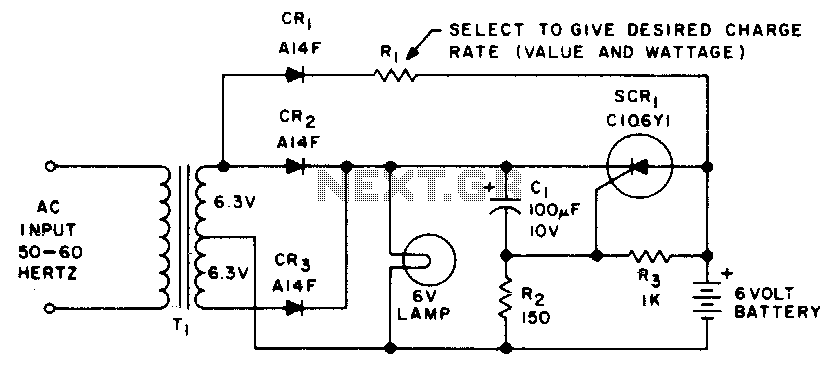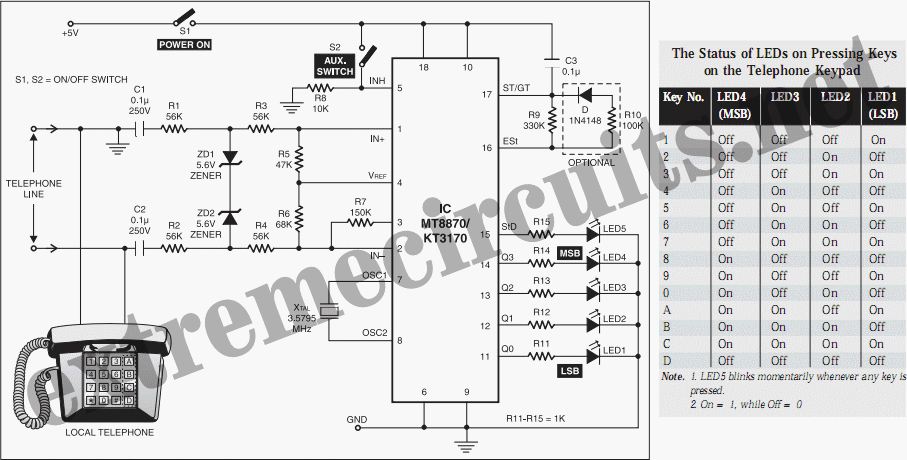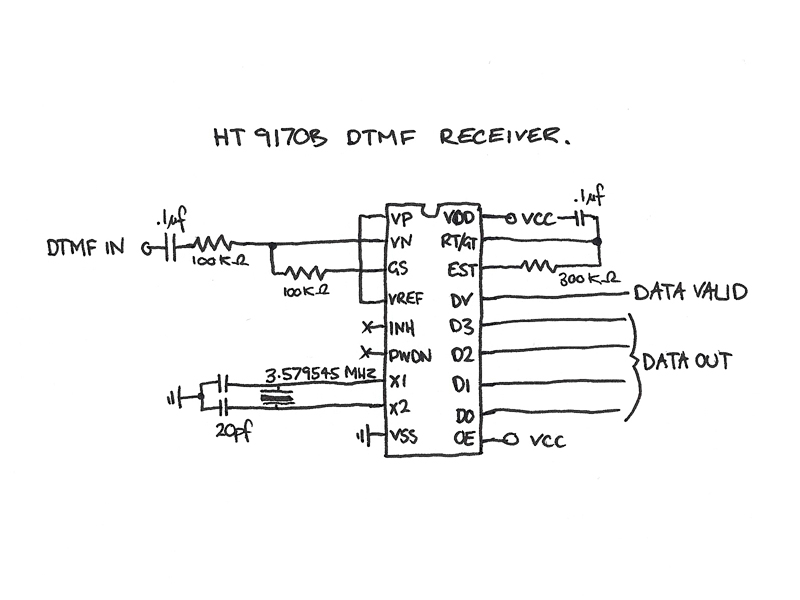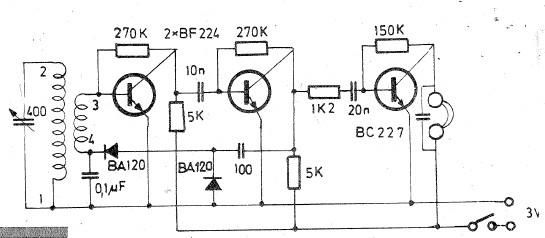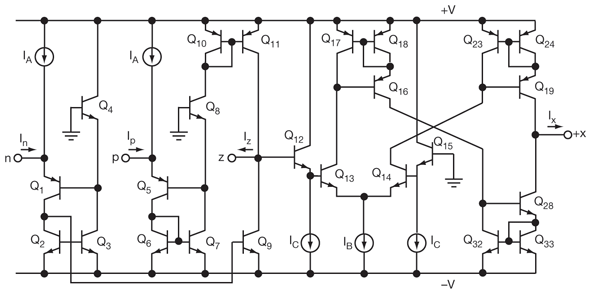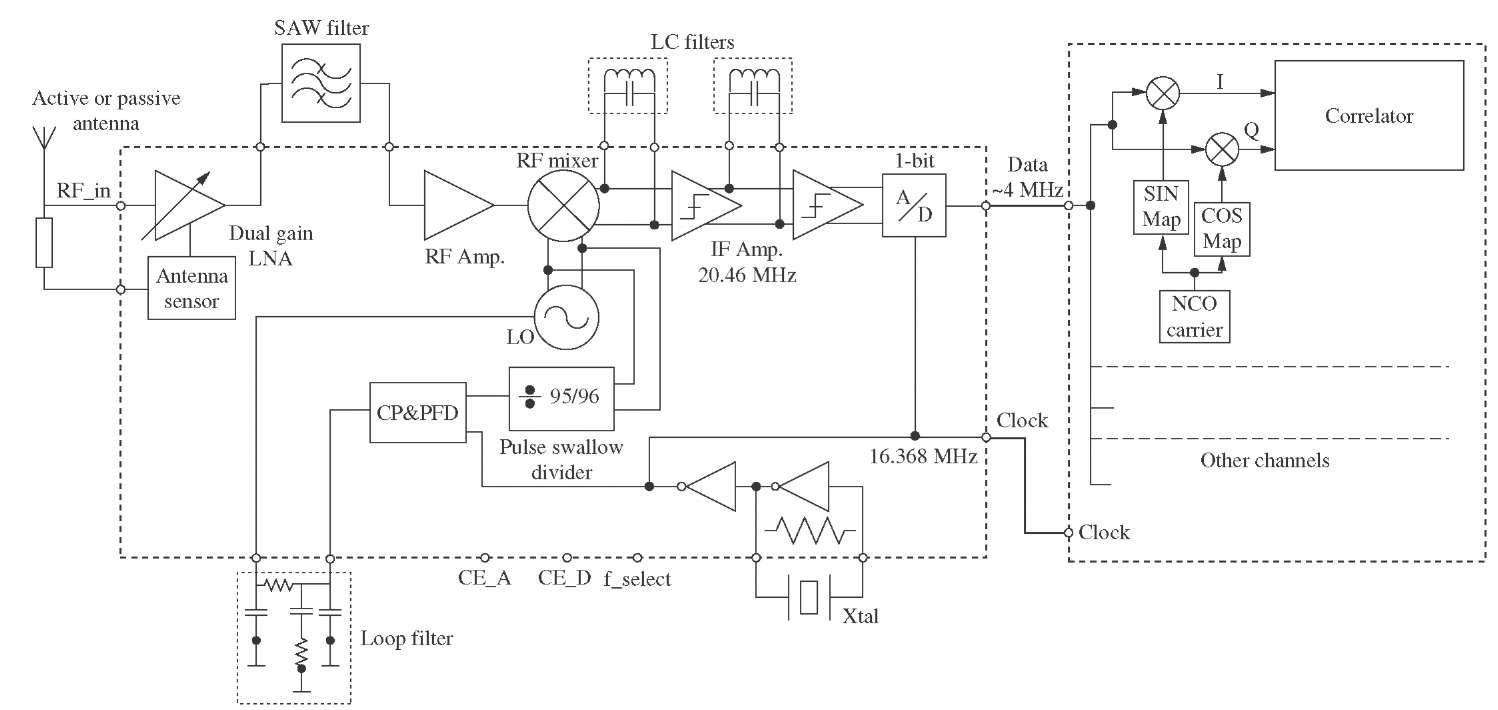
The R2 Single Sideband Direct Conversion Receiver
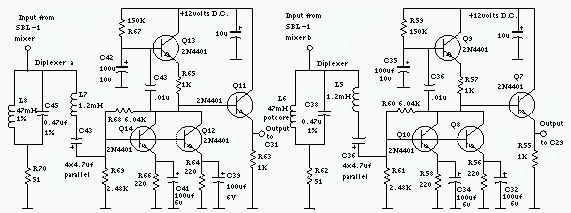
The old common-base audio preamp, which has a noise figure of 5 dB, is a clear candidate for improvement in noise performance. A common-emitter configuration with shunt feedback provides an input resistance of 50 ohms, which is preferred by the mixer, along with a reduced noise figure of 2 dB. Utilizing two paralleled 2N4401 transistors enhances the noise performance at this low input impedance. A gain of 60 effectively masks most of the noise from the operational amplifier phase shifter that follows. Common collector output stages yield a low output impedance necessary for driving the audio phase shifter. A simplified diplexer between the mixer and preamp also contributes to a lower noise figure. Rick's R2 diplexer has a steeper stopband slope but incurs approximately 2 dB of loss. The TOKO 10RB inductors exhibit excessive series resistance; therefore, custom inductors were wound on small potcores measuring 14x8 mm. Although potcore bobbins are straightforward to wind, achieving precise inductance can be challenging, as excessive pressure from mounting screws can significantly alter inductance values. It is advisable to use potcore mounting hardware from the manufacturer. The 1.2 mH inductor should possess low internal capacitance, constructed with 35 turns of #32 wire in a single layer on a FT37-77 ferrite toroid. The diplexer's low-pass frequency is set at 6700 Hz, while the high-pass frequency is at 170 Hz, both of which fall outside the audio passband of 350 to 3500 Hz. This design choice minimizes unwanted phase shifts from mismatched diplexer components, reducing the necessity for highly accurate component values. The tuning method described allows for the mitigation of negative effects from mismatched components. Despite this, diplexer components were matched using a commercial Maxwell impedance bridge. The phasing resistors and capacitors were scaled to ensure that resistor values remained relatively low. Higher resistor values would introduce significant Johnson noise, necessitating greater preamp gain to maintain the same noise figure. A return to a low-noise bipolar operational amplifier (LM837) results in lower noise compared to the FET-input TL074 with these reduced resistor values. The Motorola MC33079P is also compatible. Most low-noise operational amplifiers exhibit an extended frequency response as an additional benefit. Circuit layout exhibited slight instability, oscillating at 3 MHz. Operating at a low power supply voltage exacerbates this issue, but the primary cause of oscillation is likely excessive stray capacitance between inputs and ground. A 10 pF feedback capacitor typically suffices to resolve this issue without introducing significant phase error. A more straightforward USB/LSB sideband switching arrangement reduces the number of required operational amplifiers. This phasing circuit achieves high sideband suppression, achieving a minimum of 58 dB. As noted by Rick, achieving this effectively is quite challenging, primarily due to component tolerances. Capacitors C24, C25, C26, C27, C28, and C30 should be of the same type, with Panasonic P-Series (polypropylene) capacitors offering tight tolerances and good temperature stability. Philips 460 series capacitors are superior but are not available in larger sizes. Polystyrene capacitors are also suitable, but only in smaller values. Most resistors should be 1% precision types. Trimming these components is often viewed as overly complex, partly due to the requirement for a quadrature signal generator. A simple and accurate quadrature generator can be constructed using two common CMOS chips. This circuit can be temporarily assembled on a protoboard to adjust the three phasing trimpots (R43, R47, and R51) for optimal alternate sideband suppression. The signal generator must deliver two signals of identical frequency and amplitude, with a precise 90-degree phase relationship. Since each of the three trimpots affects audio frequencies differently, these signals must be frequency agile, ranging from 300 to 4000 Hz. Two square waves in quadrature can be generated easily using a logic shift register. However, the harmonics of these square waves...
The described audio preamp circuit utilizes advanced design techniques to minimize noise and improve performance. The transition from a common-base configuration to a common-emitter setup significantly enhances the noise figure, making it suitable for sensitive audio applications. The choice of using paralleled 2N4401 transistors is a strategic one, as it effectively lowers the noise performance at the desired input impedance, which is crucial for compatibility with the mixer stage.
The implementation of a diplexer serves to filter unwanted frequencies, with careful attention given to the design parameters such as the low-pass and high-pass cutoff frequencies. This allows for better control over the audio signal, ensuring that only the desired frequencies pass through while attenuating others that could introduce noise or distortion.
Custom inductors wound on potcores demonstrate a practical approach to achieving the necessary inductance while managing series resistance effectively. The use of low-capacitance inductors is vital for maintaining signal integrity, particularly in high-frequency applications.
The design also incorporates precision components, emphasizing the importance of matching and tolerances in achieving optimal performance. The decision to use low-noise operational amplifiers, such as the LM837 and MC33079P, further enhances the overall noise performance of the preamp stage.
The careful layout of the circuit and the addition of feedback capacitors to mitigate oscillations reflect a thorough understanding of high-frequency circuit behavior. The implementation of a quadrature generator for precise tuning of the phasing trimpots demonstrates a commitment to achieving high-performance audio processing.
Overall, the described circuit represents a sophisticated approach to audio preamplification, combining innovative design elements with practical engineering solutions to achieve low noise and high fidelity in audio applications.The old common-base audio preamp, having a noise figure of 5dB is an obvious target to improve the noise figure. A common-emitter configuration, with shunt feedback gives 50 ohms input resistance (preferred by the mixer) and a 2dB noise figure.
Two paralleled 2N4401 transistors results in better noise performance at such a low input impedance. A g ain of 60 masks most of the noise in the op-amp phase shifter that follows. Common collector ouput stages provide a low output impedance needed to drive the audio phase shifter. A simpler diplexer between mixer and preamp shaves a little off the noise figure too. Rick`s R2 diplexer has steeper stopband slope, but about 2dB loss. The TOKO 10RB inductors simply have too much series resistance: I wound my own on small potcores, 14x8 mm.
The potcore bobbins are very easy to wind, but its tricky to get the inductance exact - too much pressure from a mounting screw can change inductance dramatically. Potcore mounting hardware from the manufacturer is recommended. The 1. 2mH inductor should have low internal capacitance - 35 turns #32 wire in a single layer on a FT37-77 ferrite toroid.
Diplexer low-pass frequency at 6700 Hz. , and high-pass frequency at 170 Hz are outside the audio passband (350 - 3500 Hz. ). This means that unwanted phase shifts from mismatched diplexer parts are less troublesome, relaxing the need for extremely accurate component values. With the tuning method described below, some of the bad effects of mismatched components can be tuned out.
Nevertheless, diplexer components were matched with the aid of a commercial Maxwell impedance bridge. The phasing R`s and C`s were all scaled so that resistor values were much smaller. Otherwise, the Johnson noise from those warm, large value resistors adds so much noise that preamp gain would have to be much higher to achieve the same noise figure.
A return to a low- noise bipolar op-amp (LM837) gives lower noise than the FET-input TL074 with these lower resistor values. The Motorola MC33079P should work equally well. Most low-noise op-amps have extended frequency response as a side-effect. My circuit layout was slightly unstable, oscillating at 3 Mhz. Running at low power supply voltage doesn`t help, but oscillations are most likely caused by too much stray capacitance between the inputs and ground.
A 10pF feedback capacitor is usually enough to correct the problem, and doesn`t add noticeable phase error. A simpler USB/LSB sideband switching arrangement means a few less op-amps. This phasing circuit is capable of high sideband suppression; a minimum of 58 dB (figure 1). As Rick has mentioned, actually doing this well is very very difficult, mostly because of component tolerances.
Capacitors C24, C25, C26, C27, C28, C30 should all be of the same type. The Panasonic P-Series (polypropylene) capacitors have tight tolerance, and good temperature stability. Philips 460 series are even better, but unavailable in the larger sizes. Polystyrene capacitors are good too, but only small values are available. Almost all the resistors should be 1% precision resistors. Trimming these components is considered by many to be too difficult, partly because of the need for a quadrature signal generator.
I`m a believer in building your own test equipment; a very simple and accurate quadrature generator was developed that uses two common CMOS chips. This circuit can be built temporarily on a protoboard to trim the three phasing trimpots R43, R47, and R51 for best alternate sideband suppression.
The signal generator must supply two signals of the same frequency, same amplitude, but with exactly a 90 degree phase relationship. Since each of the three trimpots to be tuned affects some audio frequencies more than others, these two signals must be frequency agile: 300 - 4000 Hz.
Two square waves in quadrature are easily generated with a logic shift register. However, the harmonics of those squar 🔗 External reference
The described audio preamp circuit utilizes advanced design techniques to minimize noise and improve performance. The transition from a common-base configuration to a common-emitter setup significantly enhances the noise figure, making it suitable for sensitive audio applications. The choice of using paralleled 2N4401 transistors is a strategic one, as it effectively lowers the noise performance at the desired input impedance, which is crucial for compatibility with the mixer stage.
The implementation of a diplexer serves to filter unwanted frequencies, with careful attention given to the design parameters such as the low-pass and high-pass cutoff frequencies. This allows for better control over the audio signal, ensuring that only the desired frequencies pass through while attenuating others that could introduce noise or distortion.
Custom inductors wound on potcores demonstrate a practical approach to achieving the necessary inductance while managing series resistance effectively. The use of low-capacitance inductors is vital for maintaining signal integrity, particularly in high-frequency applications.
The design also incorporates precision components, emphasizing the importance of matching and tolerances in achieving optimal performance. The decision to use low-noise operational amplifiers, such as the LM837 and MC33079P, further enhances the overall noise performance of the preamp stage.
The careful layout of the circuit and the addition of feedback capacitors to mitigate oscillations reflect a thorough understanding of high-frequency circuit behavior. The implementation of a quadrature generator for precise tuning of the phasing trimpots demonstrates a commitment to achieving high-performance audio processing.
Overall, the described circuit represents a sophisticated approach to audio preamplification, combining innovative design elements with practical engineering solutions to achieve low noise and high fidelity in audio applications.The old common-base audio preamp, having a noise figure of 5dB is an obvious target to improve the noise figure. A common-emitter configuration, with shunt feedback gives 50 ohms input resistance (preferred by the mixer) and a 2dB noise figure.
Two paralleled 2N4401 transistors results in better noise performance at such a low input impedance. A g ain of 60 masks most of the noise in the op-amp phase shifter that follows. Common collector ouput stages provide a low output impedance needed to drive the audio phase shifter. A simpler diplexer between mixer and preamp shaves a little off the noise figure too. Rick`s R2 diplexer has steeper stopband slope, but about 2dB loss. The TOKO 10RB inductors simply have too much series resistance: I wound my own on small potcores, 14x8 mm.
The potcore bobbins are very easy to wind, but its tricky to get the inductance exact - too much pressure from a mounting screw can change inductance dramatically. Potcore mounting hardware from the manufacturer is recommended. The 1. 2mH inductor should have low internal capacitance - 35 turns #32 wire in a single layer on a FT37-77 ferrite toroid.
Diplexer low-pass frequency at 6700 Hz. , and high-pass frequency at 170 Hz are outside the audio passband (350 - 3500 Hz. ). This means that unwanted phase shifts from mismatched diplexer parts are less troublesome, relaxing the need for extremely accurate component values. With the tuning method described below, some of the bad effects of mismatched components can be tuned out.
Nevertheless, diplexer components were matched with the aid of a commercial Maxwell impedance bridge. The phasing R`s and C`s were all scaled so that resistor values were much smaller. Otherwise, the Johnson noise from those warm, large value resistors adds so much noise that preamp gain would have to be much higher to achieve the same noise figure.
A return to a low- noise bipolar op-amp (LM837) gives lower noise than the FET-input TL074 with these lower resistor values. The Motorola MC33079P should work equally well. Most low-noise op-amps have extended frequency response as a side-effect. My circuit layout was slightly unstable, oscillating at 3 Mhz. Running at low power supply voltage doesn`t help, but oscillations are most likely caused by too much stray capacitance between the inputs and ground.
A 10pF feedback capacitor is usually enough to correct the problem, and doesn`t add noticeable phase error. A simpler USB/LSB sideband switching arrangement means a few less op-amps. This phasing circuit is capable of high sideband suppression; a minimum of 58 dB (figure 1). As Rick has mentioned, actually doing this well is very very difficult, mostly because of component tolerances.
Capacitors C24, C25, C26, C27, C28, C30 should all be of the same type. The Panasonic P-Series (polypropylene) capacitors have tight tolerance, and good temperature stability. Philips 460 series are even better, but unavailable in the larger sizes. Polystyrene capacitors are good too, but only small values are available. Almost all the resistors should be 1% precision resistors. Trimming these components is considered by many to be too difficult, partly because of the need for a quadrature signal generator.
I`m a believer in building your own test equipment; a very simple and accurate quadrature generator was developed that uses two common CMOS chips. This circuit can be built temporarily on a protoboard to trim the three phasing trimpots R43, R47, and R51 for best alternate sideband suppression.
The signal generator must supply two signals of the same frequency, same amplitude, but with exactly a 90 degree phase relationship. Since each of the three trimpots to be tuned affects some audio frequencies more than others, these two signals must be frequency agile: 300 - 4000 Hz.
Two square waves in quadrature are easily generated with a logic shift register. However, the harmonics of those squar 🔗 External reference
